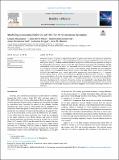| dc.contributor.author | Masandawa, Lemjini | |
| dc.contributor.author | Mirau, Silas | |
| dc.contributor.author | Mbalawata, Isambi | |
| dc.contributor.author | Paul, James | |
| dc.contributor.author | Kreppel, Katharina | |
| dc.contributor.author | Msamba, Oscar | |
| dc.date.accessioned | 2022-09-22T07:05:30Z | |
| dc.date.available | 2022-09-22T07:05:30Z | |
| dc.date.issued | 2022-06 | |
| dc.identifier.uri | https://doi.org/10.1016/j.rinp.2022.105503 | |
| dc.identifier.uri | https://dspace.nm-aist.ac.tz/handle/20.500.12479/1662 | |
| dc.description | This research article was published by Elsevier, 2022 | en_US |
| dc.description.abstract | COVID-19 epidemic has posed an unprecedented threat to global public health. The disease has alarmed the
healthcare system with the harm of nosocomial infection. Nosocomial spread of COVID-19 has been discovered
and reported globally in different healthcare facilities. Asymptomatic patients and super-spreaders are sough to
be among of the source of these infections. Thus, this study contributes to the subject by formulating a 𝑆𝐸𝐼𝐻𝑅
mathematical model to gain the insight into nosocomial infection for COVID-19 transmission dynamics. The
role of personal protective equipment 𝜃 is studied in the proposed model. Benefiting the next generation
matrix method, 𝑅0 was computed. Routh–Hurwitz criterion and stable Metzler matrix theory revealed that
COVID-19-free equilibrium point is locally and globally asymptotically stable whenever 𝑅0 < 1. Lyapunov
function depicted that the endemic equilibrium point is globally asymptotically stable when 𝑅0 > 1. Further,
the dynamics behavior of 𝑅0 was explored when varying 𝜃. In the absence of 𝜃, the value of 𝑅0 was 8.4584
which implies the expansion of the disease. When 𝜃 is introduced in the model, 𝑅0 was 0.4229, indicating the
decrease of the disease in the community. Numerical solutions were simulated by using Runge–Kutta fourth order method. Global sensitivity analysis is performed to present the most significant parameter. The numerical
results illustrated mathematically that personal protective equipment can minimizes nosocomial infections of
COVID-19. | en_US |
| dc.language.iso | en | en_US |
| dc.publisher | Elsevier | en_US |
| dc.subject | Proposed C0VID-19 model | en_US |
| dc.subject | Personal protective equipment | en_US |
| dc.subject | Basic reproduction number | en_US |
| dc.subject | Hospital-acquired infection | en_US |
| dc.title | Modeling nosocomial infection of COVID-19 transmission dynamics | en_US |
| dc.type | Article | en_US |

